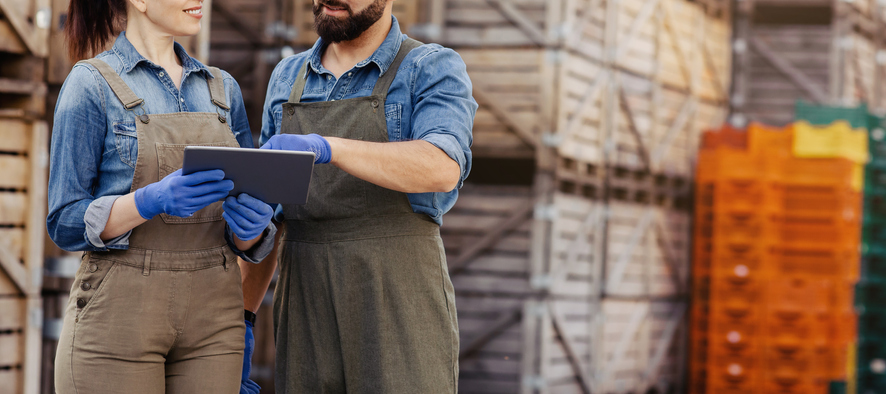The Latest Trends in Produce Automation
Wondering about the latest trends in produce automation? Read on to see how the industry is changing.

Produce automation has become an increasingly popular trend in recent years as organizations look for ways to reduce expenses and maximize efficiency.
Whether it’s a large-scale grocery store or a small local stand, more produce businesses are turning to automated solutions to help with tasks like selecting the right produce, tracking sales information, and even delivering orders directly to customers.
In this article, we’ll explore some of the latest trends in automation and how they’re changing the way that produce is grown, packaged, and shipped. We’ll also go over how technological solutions like Silo can help you make the most of your produce business.
What is produce automation?
In the produce industry, the term "automation" refers to the implementation of technology to carry out functions usually performed by human laborers. This can include activities like sorting, tallying, and packaging produce.
Automation is used to improve efficiency and reduce error, thereby cutting back on the cost of labor while maintaining the quality and consistency of produce.
Robots, sensors, data analytics systems, and packaging equipment are just some examples of the many different types of automation technologies utilized in the produce industry.
Latest trends in produce automation
The application of automation is constantly expanding, with new technologies being developed to meet produce industry demands. Here are some of the latest trends in automation.
1. Enterprise Resource Planning (ERP) solutions
Enterprise Resource Planning (ERP) solutions are becoming increasingly popular in the produce industry, as they provide an easy way to keep track of all operations within a business.
ERPs allow businesses to access data about their entire supply chain, from production to sales, quickly and easily, allowing them to make informed decisions on sourcing, inventory management, and pricing.
Additionally, ERPs as produce automation can streamline processes such as order tracking, invoicing, and product delivery, reducing the time and effort required to manage operations. Automating workflows translates into reduced overall costs through the elimination of manual tasks.
2. Robotics
Another trend in automation throughout the produce supply chain is the use of robotics for tasks in processing and shipping.
Robots in the supply chain are designed to be more precise and efficient compared to human workers, with the ability to work around the clock without needing breaks or time off. Not only does this save valuable time, but it also increases productivity significantly.
3. Sensors and data analytics
The use of sensors and data analytics in produce automation optimizes growing, shipping, and storage conditions.
Sensors can be used to monitor factors such as temperature, humidity, and soil moisture, and the data collected can then be analyzed to identify patterns and optimize conditions for the production of fruits and vegetables.
This helps improve effectiveness down the entire supply chain.
4. Packaging operations
Automation also plays a significant role in the packaging process.
Produce packaging automation technologies, such as robotic packing lines, can not only increase efficiency, but also reduce the risk of errors. These systems can handle tasks like sorting, counting, and wrapping produce at high speeds, with the need for minimal human intervention.
Advanced fruit and vegetable packing lines are being increasingly used to streamline the packaging process.
5. Smart packaging solutions
Another trend in automation is the use of smart packaging solutions to extend the shelf life of fruits and vegetables.
These solutions can include things like intelligent packaging systems, which monitor the condition of produce and alert users if it detects any issues.
These technologies help reduce food waste while improving quality and freshness for consumers.
6. AI and machine learning
Another area of innovation in produce automation is the use of artificial intelligence (AI) and machine learning.
AI systems can analyze large amounts of data to identify patterns and make predictions, which can be used to optimize the supply chain.
Machine learning algorithms can also be used to identify and classify different types of produce, which can help improve sorting and packing efficiency.
7. Other technologies
In addition to these trends, there are also a number of new technologies being developed that have the potential to revolutionize the produce industry.
For example, when it comes to automation, there are certain companies working on automated guided vehicles (AGVs), which are meant to increase the efficiency of internal logistics, particularly in fruit and vegetable warehouses.
Regardless, these solutions are congruent with the goal of providing a comprehensive solution to the automation of processes, which sees the reduction of expenses and the improvement of operational efficiency in vegetable and fruit packing lines.
Grower-shippers have much more flexibility as a result of being able to process more produce in a shorter amount of time—and at lower labor costs.
Automate operations with Silo
Technological developments have the potential to bring about dramatic change in the produce industry. Although adoption rates have a long way to go, these trends can change the way produce is grown, harvested, packaged, and shipped on a mass scale.
As technology continues to advance, it’ll become crucial to adapt to stay ahead of the competition.
Enterprise resource planning solutions like Silo can help you automate your business processes end-to-end, letting you focus on other, more critical aspects of your business. Streamline your operations and empower your people with consumable produce insights, automatic data syncing, and more!
Book a demo with Silo today!
Want to book a demo with us?
Add your info and we’ll get one scheduled with you.